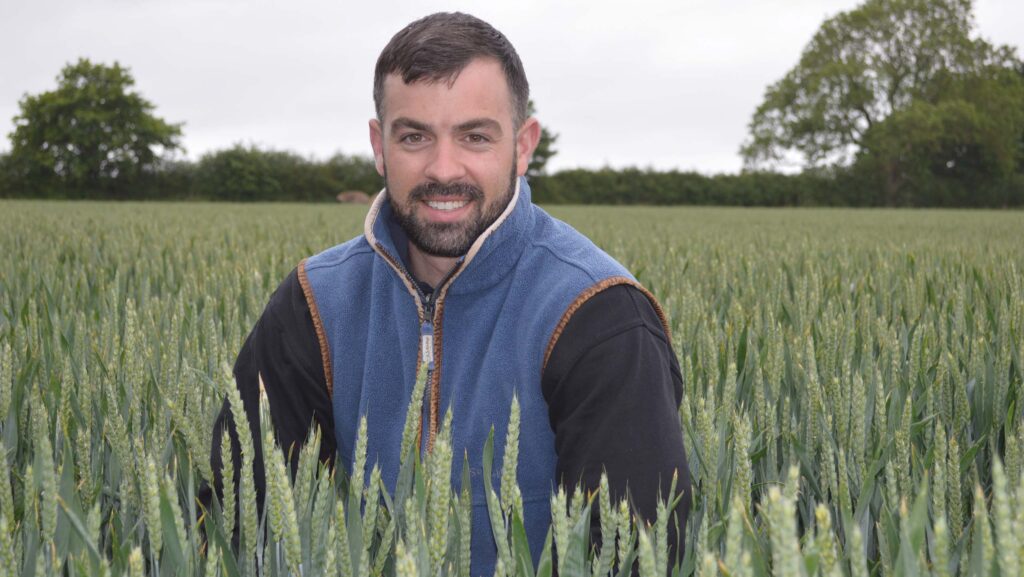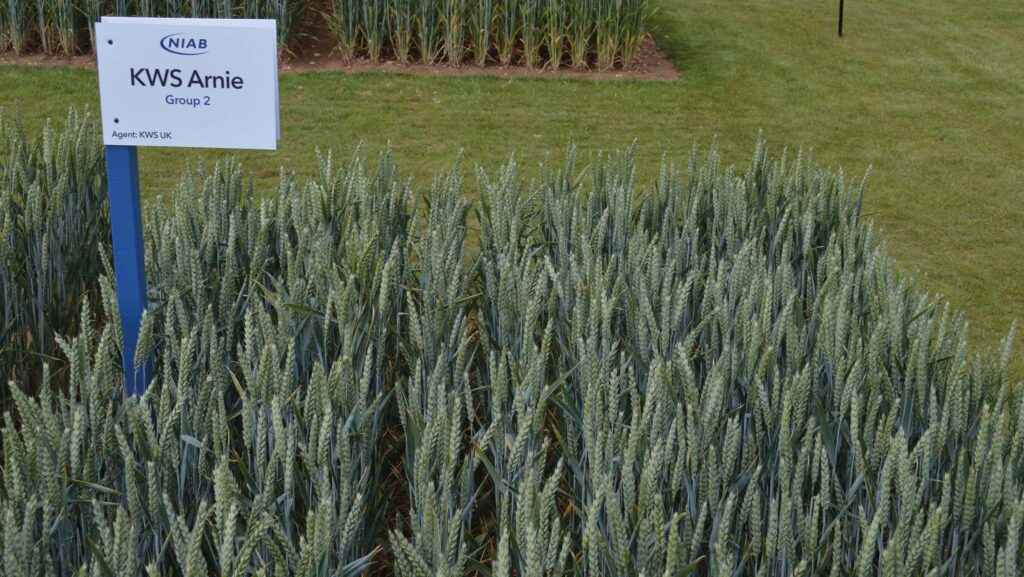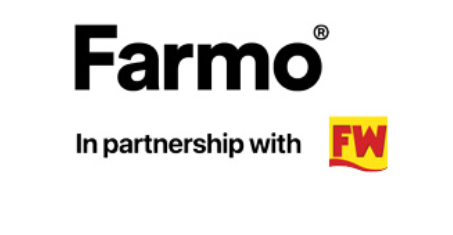Bedford grower assesses new varieties to replace Extase
Matt Fuller is set to switch to two new milling wheat varieties this autumn to replace much of his Extase area if the Group 2 millers fulfil their promise on the Bedfordshire farm he manages.
The farm was the first to grow Extase commercially in Britain for harvest 2017, but now Matt sees newer varieties Equipe and Arnie, from the same KWS plant breeder as Extase, as showing better yields and higher grain proteins.
“If these two varieties continue to perform as they have done, then they could account for the majority of our planned 250ha of Group 2 wheats this autumn,” he says.
See also: Why propyzamide use in OSR and beans remains in the balance
The predominantly heavy-land farm grows 500ha of milling wheat, with Group 1s grown in the first wheat slot, and 40-50% of the wheat area in Group 2 varieties which tend to fit in the second wheat spot.

Matt Fuller © David Jones
Group 2 premiums
The Group 2s are favoured in this position as they yield in line with Group 4 feed wheats on the farm, while there is a good market for 12.5% protein wheats.
They also tend to be early to harvest to allow for a following crop of oilseed rape.
“We can achieve price premiums without any yield drop compared with feed wheats, and there are plenty of nearby mills to supply,” he adds.
Currently, a Group 2 wheat of 12.5% protein can see premiums of £10-£20/t over feed wheat, while Group 1s making 13% protein can earn premiums of £35-£50/t.
Matt is the arable and trials manager at Heathcote Farms, near Toddington, just north-west of Luton, where he looks after 1,000ha of combinable arable cropping.
The 500ha of winter wheat saw average yields of more than 10t/ha last year.
While Group 1 milling varieties on the farm include Zyatt, Crusoe, Illustrious and Vibe, the Group 2 line-up this season includes 105ha of Extase, 72ha of Mayflower, 54ha of Equipe and 5ha of Arnie.
The yield advantage of the Group 2s over Group 1s is about 0.5t/ha on the farm, and they also have lower fungicide costs due to their better disease resistance than Group 1s, which helps to offset the lower prices premium available for Group 2s.
Last year, Group 1 wheats on the farm yielded 10-10.5t/ha, and Group 2s 10.5-11t/ha, and the Group 2s usually show proteins of not less than 12%, and often 12.5%-plus.
Three new group 2 wheat varieties compared with Extase |
||||
|
|
Extase |
Arnie |
Equipe |
Newbie |
|
Fungicide-treated yield (%) |
102 |
106 |
103 |
103 |
|
Untreated yield (%) |
91 |
87 |
92 |
85 |
|
Disease resistance |
||||
|
Yellow rust* |
7 |
7 |
7 |
9 |
|
Brown rust* |
7 |
6 |
7 |
6 |
|
Septoria tritici* |
7.0 |
7.0 |
7.0 |
6.2 |
|
Agronomic features |
||||
|
Lodging resistance without plant growth regulator* |
7 |
8 |
7 |
7 |
|
Ripening (days +/-Skyfall) |
-1 |
0 |
-1 |
0 |
|
Grain quality |
||||
|
Protein – milling spec (%) |
12.3 |
12.1 |
12.2 |
12.5 |
|
Hagberg (seconds) |
287 |
287 |
305 |
305 |
|
Specific weight (kg/hl) |
79.2 |
79.1 |
79.5 |
78.4 |
|
*On a scale of 1-9, with 9 showing the characteristic most strongly |
||||
Farm trials
In farm trials last harvest, Equipe slightly edged ahead of Extase with a yield of 10.2t/ha at 11.3% protein compared with Extase at 9.9t/ha and 11.2% protein.
Arnie impressed with a yield of 12.2t/ha at a diluted protein of 11.1%, putting it at least 2t/ha ahead of first two, and so has the potential to eventually replace Extase.
If Arnie performs well this harvest, Matt is pencilling in 100ha for the variety, with the remaining 150ha of Group 2 wheats made up of Equipe, Extase and Mayflower depending of their relative performances this harvest.
“In the second wheat slot, it could be Arnie and Equipe next season rather than Extase and Equipe at the moment.
“We expect Arnie to do well again for us and if that is the case then we are likely to have a 100ha block next season,” he adds.
The third of the Group 2 KWS newcomers, Newbie, performed well at 10.4t/ha and 11.2% protein in the farm trial, and looks a decent variety but may prove more useful in the north of Britain because of its better performance there and shorter straw.
Mayflower is grown as it fills in the early drilling slot. With little blackgrass on the farm, it can be drilled safely in September and it has the highest septoria resistance rating on the current AHDB’s Recommended List.
When making variety choice, Matt often looks to the performance of wheat varieties in the wetter west of the country to give a good idea of those that perform well and where the pressure from the wet-loving septoria is greater.
Drilling for the Group 2 varieties Extase, Arnie and Equipe tends to be in the first half of October as they are all vigorous growers through the autumn, with the drilling rate aimed at 325-400 seeds/sq m depending on the timing of sowing.
This season
All second wheats this season were drilled in the second week of November after a wet October, when 150mm of rain fell in one weekend, and Matt was particularly impressed with how Arnie performed after a 14 November drilling date.
Second wheats on the farm receive 240kg/ha of nitrogen. The first doses are liquid before moving to solid to avoid scorch, with the aim to get 12.5%-plus protein wheats.
Fungicide costs have come down to £90-£100/ha this season due the dry weather easing disease pressure, and they are running £20-£30/ha below a “normal” season.
After a biostimulant at T0, the crops have received a relatively standard T1, T2 and T3 spray programme, with septoria seen as the main disease to watch out for on the farm.
The Group 2 wheats have generally good resistance to septoria with Extase, Arnie and Equipe all being rated a 7 on the AHDB RL 1-9 rating scheme, with 1 being very susceptible and 9 showing good resistance.
“The better septoria rating of the Group 2 wheats mean we do not have to chase around so much in the spring and so there is a more of a spray window,“ says Matt.
“Choosing those varieties with an inherently high level of genetic resistance has become increasing important to provide a sound basis for an effective disease control programme and high yields,” he adds.
Trade views
Arnie is the favoured variety out of the three new KWS Group 2 milling wheats for Jim Knightbraid, seed business development manager for big seed supplier Frontier Agriculture.
“Arnie is by far the standout variety of the three for growers looking for good yields and good disease resistance,” he says.
The variety performs particularly well in the West, showing its good septoria resistance, while signs show it has not broken down to yellow rust following reports of the Yr15 resistance gene being overcome, which is affecting other varieties, Jim adds.
He points out that Equipe would be attractive to growers looking for an improved Extase-type, and has the attraction of an early harvest and top untreated yield.
His colleague Nicky Wilson, the group’s regional seeds manager (Scotland), sees many positives for Arnie in her area, stretching from the River Humber to the Black Isle, north of Inverness.

© David Jones
Although her customers in Scotland and northern England focus mainly on feed wheats, Extase has been a mainstay for her company since its launch in 2019, and so there is a market for these Group 2 wheats.
Unlike Extase, which should not be sown too early, Arnie can go in early, she says. It shows a step up in yield over Extase of 2% in her northern region and has a good disease resistance package, stiff straw and good grain quality.
Extase has been a very reliable variety over the past six years, whether the season has been early or late, wet or dry, and through cold, hard winters, and Arnie looks like being another consistent performer for growers, she adds.
“With profit margins tight, minimising risk has become a major factor, so they need varieties that deliver reliable, consistent performance across all conditions and from season to season,” she says.
Breeder view
The three new Group 2 milling wheats are looking to build on the success of Extase, and push yields above that for the variety that was often grown for its good disease resistance package as much as its price premium.
Two of the new varieties are Extase-crosses – Arnie and Equipe – while Newbie is a Zyatt-cross.
Extase helped revive the Group 2 milling market when it was introduced a number of years ago, showing the highest fungicide untreated yield and best septoria score on the then AHDB Recommended List (RL), although it has now been overtaken on these top scores.
It was key “agronomic tools” such as septoria resistance and stiff straw that have become more relevant for growers, and these three newcomers hope to emulate and improve on Extase.
Arnie
This variety is now the top-yielding Group 2 variety, with a fungicide-treated yield of 106%, 4% ahead of Extase with a slightly stiffer straw and a similar septoria score.
Olivia Bacon, KWS’s product manager for wheat, says these characteristics will appeal to growers looking for a strong variety capable of good yield performance, and she sees it as a good all-rounder.
“The variety holds its own against top-performing hard feed wheats, with a treated yield on a par with market-leading options.
“With outstanding disease resistance, it is the best-performing breadmaking variety in the second or more slot,” she says.
Its fungicide-treated yield is only 2% below the best-yielding feed winter wheats, with a similar resistance rating to Extase – 7 for yellow rust and 7 for septoria.
The variety shows a similar Hagberg to Extase, but very slightly lower specific weight and protein content.
Equipe
This variety comes from the group’s French plant breeding programme and is the most similar to Extase of the three newcomers, albeit with a higher yield and better grain quality.
Like Extase, the breeder recommends that growers do not drill Equipe any earlier than the first week of October, with mid-October being seen as the best drilling window due to the variety’s rapid early growth.

© David Jones
The new variety gives a fungicide-treated of 103%, 1% ahead of Extase, while it takes over the mantle from Extase as the top-yielding overall wheat on the RL for an untreated fungicide yield of 92%.
It has a slightly higher specific weight and Hagberg than Extase, but a slightly lower protein content.
Newbie
Newbie is the only one of the three not to have Extase directly in its parentage and shows a particularly good performance in the North.
It shows a fungicide-treated yield of 103%, just ahead of Extase’s 102%, but with its good northern yield and a 6cm shorter straw than Extase, it could do well in that region.
Olivia points out that in the North, Newbie achieved a yield of 107% and so outcompeted many northern feed favourites such as Skyscraper on 100% and Gleam on 104% in northern yield figures.
It shows better yellow rust resistance than Extase, scoring a 9, but is down on septoria at a 6.2, while it gives the highest protein of all the four KWS varieties at 12.5%.
She advises that because of the variety’s fast-developing, high-tillering habit, it should not be sown before the end of September.
- For this autumn, there should be plentiful supplies of Arnie, enough to take up 5.5% of the certified wheat seed market, but supplies of Equipe could make up just 1% and Newbie only 0.5%.

